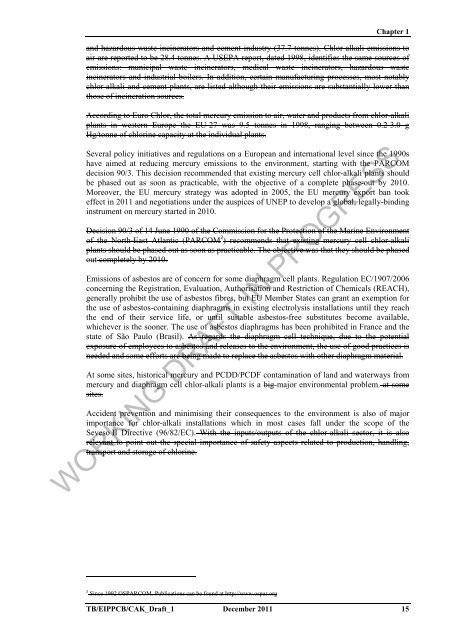(BAT) Reference Document for the Production of Chlor-alkali ...
(BAT) Reference Document for the Production of Chlor-alkali ...
(BAT) Reference Document for the Production of Chlor-alkali ...
Create successful ePaper yourself
Turn your PDF publications into a flip-book with our unique Google optimized e-Paper software.
Chapter 1<br />
and hazardous waste incinerators and cement industry (37.7 tonnes). <strong>Chlor</strong>-<strong>alkali</strong> emissions to<br />
air are reported to be 28.4 tonnes. A USEPA report, dated 1998, identifies <strong>the</strong> same sources <strong>of</strong><br />
emissions: municipal waste incinerators, medical waste incinerators, hazardous waste<br />
incinerators and industrial boilers. In addition, certain manufacturing processes, most notably<br />
chlor-<strong>alkali</strong> and cement plants, are listed although <strong>the</strong>ir emissions are substantially lower than<br />
those <strong>of</strong> incineration sources.<br />
According to Euro <strong>Chlor</strong>, <strong>the</strong> total mercury emission to air, water and products from chlor-<strong>alkali</strong><br />
plants in western Europe <strong>the</strong> EU-27 was 9.5 tonnes in 1998, ranging between 0.2-3.0 g<br />
Hg/tonne <strong>of</strong> chlorine capacity at <strong>the</strong> individual plants.<br />
Several policy initiatives and regulations on a European and international level since <strong>the</strong> 1990s<br />
have aimed at reducing mercury emissions to <strong>the</strong> environment, starting with <strong>the</strong> PARCOM<br />
decision 90/3. This decision recommended that existing mercury cell chlor-<strong>alkali</strong> plants should<br />
be phased out as soon as practicable, with <strong>the</strong> objective <strong>of</strong> a complete phase-out by 2010.<br />
Moreover, <strong>the</strong> EU mercury strategy was adopted in 2005, <strong>the</strong> EU mercury export ban took<br />
effect in 2011 and negotiations under <strong>the</strong> auspices <strong>of</strong> UNEP to develop a global, legally-binding<br />
instrument on mercury started in 2010.<br />
Decision 90/3 <strong>of</strong> 14 June 1990 <strong>of</strong> <strong>the</strong> Commission <strong>for</strong> <strong>the</strong> Protection <strong>of</strong> <strong>the</strong> Marine Environment<br />
<strong>of</strong> <strong>the</strong> North-East Atlantic (PARCOM 2 ) recommends that existing mercury cell chlor-<strong>alkali</strong><br />
plants should be phased out as soon as practicable. The objective was that <strong>the</strong>y should be phased<br />
out completely by 2010.<br />
Emissions <strong>of</strong> asbestos are <strong>of</strong> concern <strong>for</strong> some diaphragm cell plants. Regulation EC/1907/2006<br />
concerning <strong>the</strong> Registration, Evaluation, Authorisation and Restriction <strong>of</strong> Chemicals (REACH),<br />
generally prohibit <strong>the</strong> use <strong>of</strong> asbestos fibres, but EU Member States can grant an exemption <strong>for</strong><br />
<strong>the</strong> use <strong>of</strong> asbestos-containing diaphragms in existing electrolysis installations until <strong>the</strong>y reach<br />
<strong>the</strong> end <strong>of</strong> <strong>the</strong>ir service life, or until suitable asbestos-free substitutes become available,<br />
whichever is <strong>the</strong> sooner. The use <strong>of</strong> asbestos diaphragms has been prohibited in France and <strong>the</strong><br />
state <strong>of</strong> São Paulo (Brasil). As regards <strong>the</strong> diaphragm cell technique, due to <strong>the</strong> potential<br />
exposure <strong>of</strong> employees to asbestos and releases to <strong>the</strong> environment, <strong>the</strong> use <strong>of</strong> good practices is<br />
needed and some ef<strong>for</strong>ts are being made to replace <strong>the</strong> asbestos with o<strong>the</strong>r diaphragm material.<br />
At some sites, historical mercury and PCDD/PCDF contamination <strong>of</strong> land and waterways from<br />
mercury and diaphragm cell chlor-<strong>alkali</strong> plants is a big major environmental problem. at some<br />
sites.<br />
Accident prevention and minimising <strong>the</strong>ir consequences to <strong>the</strong> environment is also <strong>of</strong> major<br />
importance <strong>for</strong> chlor-<strong>alkali</strong> installations which in most cases fall under <strong>the</strong> scope <strong>of</strong> <strong>the</strong><br />
Seveso II Directive (96/82/EC). With <strong>the</strong> inputs/outputs <strong>of</strong> <strong>the</strong> chlor-<strong>alkali</strong> sector, it is also<br />
relevant to point out <strong>the</strong> special importance <strong>of</strong> safety aspects related to production, handling,<br />
transport and storage <strong>of</strong> chlorine.<br />
WORKING DRAFT IN PROGRESS<br />
2 Since 1992 OSPARCOM. Publications can be found at http://www.ospar.org<br />
TB/EIPPCB/CAK_Draft_1 December 2011 15







